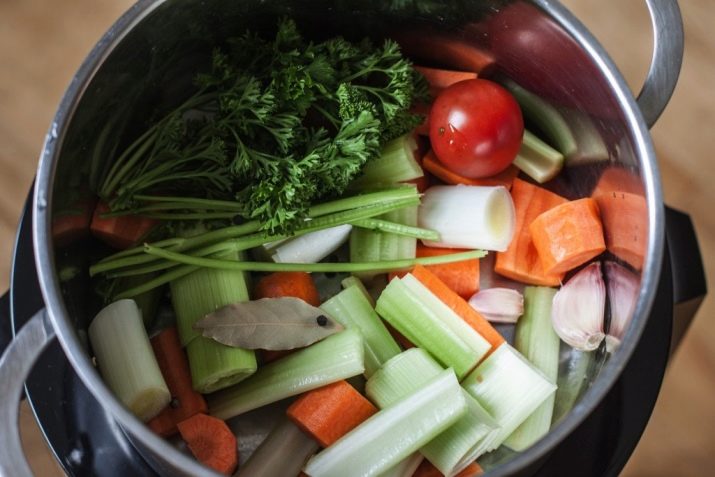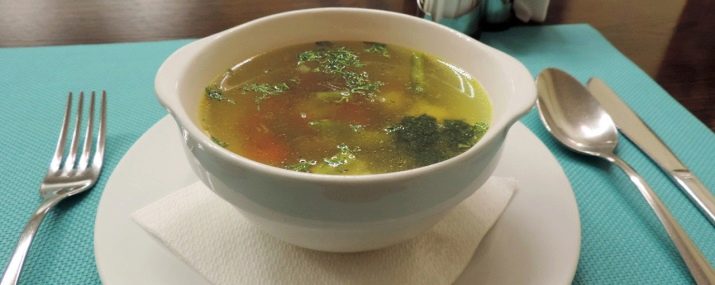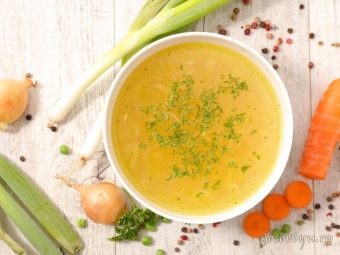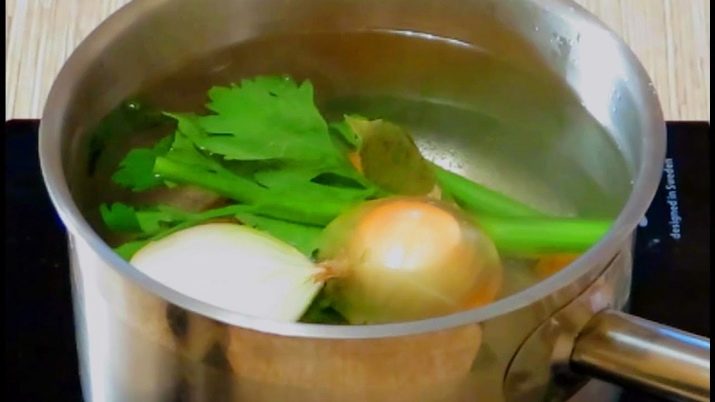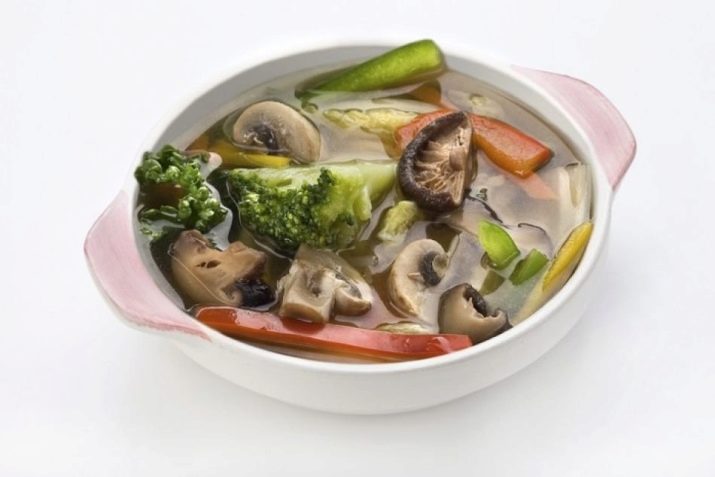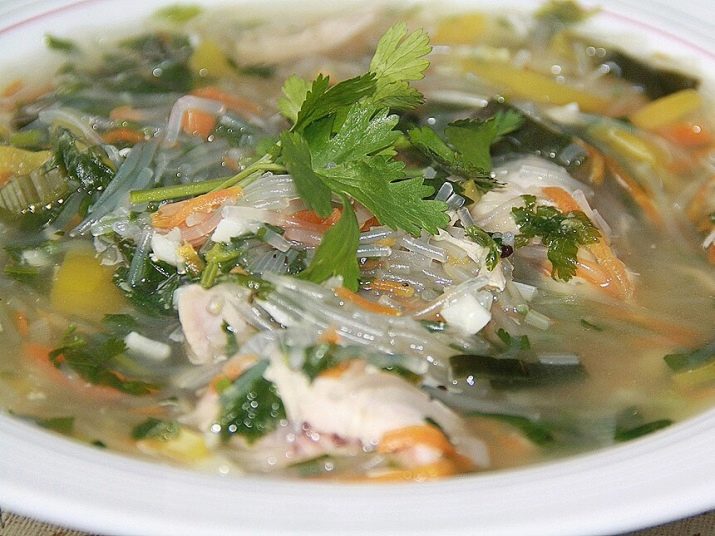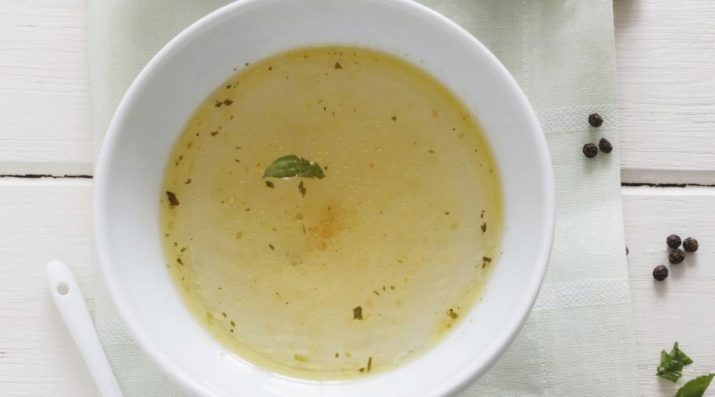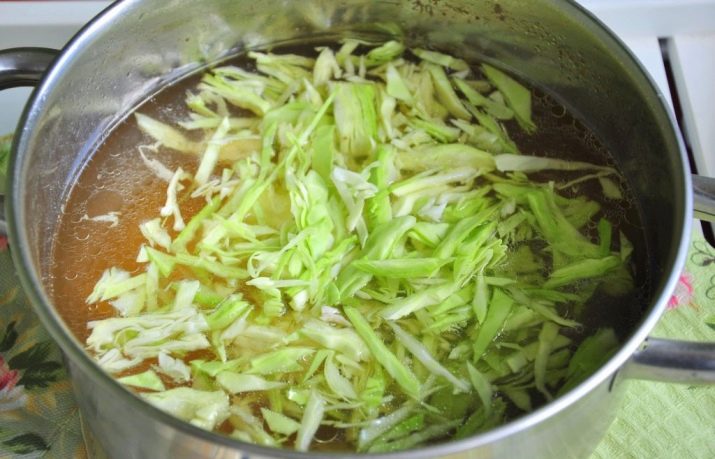How to cook vegetable broth?

Vegetable broth is a universal billet, which is widely used in cooking for making soups, sauces, and various main courses of cereals, fish and meat. The product is recommended for inclusion in the diet, because it has a high nutritional value and low calorie content.
Special features
Few people know, but the definitions of "broth" and "boiler" are closely related to each other. Many believe that the boiler means belonging to meat products, however, in fact, the term comes from the French word "boil". And it fully reflects the whole essence of cooking broth - the original components are placed in water and boiled for a long time. Depending on what kind of product was taken as a basis, separate meat and vegetable dishes. If the former are well known to everyone, then the features and rules of preparing the latter should be told separately.
The earliest mentions of vegetable broths are found in ancient Egyptian papyrus, as well as in ancient recipes of ancient Chinese cooks. The exact date (when exactly they started cooking) is unknown, but in any case, the emergence of a hot method of processing vegetables, no doubt, became a landmark event in culinary art. Thanks to him, it became possible to preserve the beneficial properties of decoctions for quite a long time.
Nowadays, cooks everywhere use broths to create vegetarian soups, sauces, and side dishes. However, meat lovers should not refuse from such a preparation - if you add meatballs, sausage or cheese to it, you can get a rather tasty and savory dish.
Many housewives prepare such broths for future use, after which they are distributed into separate portions and frozen in plastic or glass vessels. However, the value of vegetable broth does not end there. The product is considered major in the system of diet and baby food. In this case, it is boiled without adding salt from 3-4 vegetables. This product is the best suited for patients recovering from a serious illness.
The nutritional value of the product is great. Vegetable broth contains a large amount of vitamins, as well as useful microelements, which are necessary for the human body to maintain normal vital activity. The use of such a decoction allows you to activate the body's defenses, and also significantly improves your well-being. The product acquires special value in the cold season. It was during this period that the body experienced an acute lack of vitamins due to the lag of fresh herbs, fruits and vegetables. In addition, vegetable broth has been proven to resist the development of cardiovascular pathologies and neoplastic processes, and its antioxidants can stop age-related changes and stimulate the regeneration of organs and tissues.
Calorie content
Vegetable broth is exceptionally low in calories - 100 g of the product contains only 12.8 kcal. The amount of proteins is 0.65 g, fat - 0.2 g, and carbohydrates - 2.4 g. The energy value of BJU is 20% / 13% / 18%, respectively.
Due to its properties, the product is often included in the composition of various diets. He perfectly fills the deficiency of vitamins in the body. In addition, it restores the water-salt balance, normalizes metabolism and at the same time is absorbed by the body rather quickly. Because of the low content of calories, vegetable-based decoctions are often consumed by women who struggle with excess weight.
Speaking about the composition and nutritional value of the product, it should be mentioned about its potential harm. By itself, the broth can not cause harm, but only if the products were selected quality.
If, for the base of the broth, vegetables are stuffed with chemicals, there will be no benefit from it, and in some cases it may even harm the person.That is why when preparing such a dish it is important to pay attention not only to the composition and caloric content of the vegetables used, but also to their ecological purity.
Preparing food and dishes
Obviously, vegetables and fresh water are necessary for boiling vegetable broth. Keep in mind that it is water that is considered the main course. In this regard, it is not necessary to take the one that flows from our kitchen faucets. It is best to take filtered or mineral (only non-carbonated), since the degree of transparency of the prepared broth, its taste and smell depend on the quality and chemical composition of this component.
As for vegetables, everything is elementary here - the more will be the most diverse gifts of nature, the richer and more delicious the decoction will come out, although some advice from experienced chefs is worth taking note of.
- Carrots add some sweetness to vegetable broth, and if you fry it a little beforehand, the dish will turn out to be quite sweet.
- If you plan to put the Bulgarian pepper, then the smell will be quite sharp and completely kill the aroma of other products, so this broth is usually used for letting in poultry and meat.
- If you want to give the finished dish a little sourness and astringency, add tomatoes to it, and if they are sluggish, the flavor will be even thicker and even a little meaty.
- The very fragrant broth comes from ordinary cabbage, although it makes it a bit cloudy.
- Cauliflower, like broccoli, transfers all of its useful vitamins to the prepared dish, due to which such soups are often included in the children's diet.
- Keep in mind that if you are cooking broth from pre-fried vegetables, then its appearance and smell will be completely different than when boiling raw.
- For vegetable broths, a regular pan or multi-cooker is suitable.
General cooking rules
Regardless of what ingredients you use, there are a few basic rules for cooking vegetable decoction. To get rich and appetizing broth, you should pour all the products cooked and cut into pieces and boil them after boiling for about 15-20 minutes.
Onions it is desirable to replace leeks, despite the fact that it is more expensive. The difference of dishes is felt quite strongly. Leek makes the liquid much more transparent, does not lead to turbidity and does not give unpleasant bitterness to the broth. In addition, the liquid acquires a rather subtle flavor, which makes soups and gravy cooked on the basis of dishes more appetizing and tasty.
If you buy a vegetable product in the form of frozen cubes, then you should not defreeze them. It is enough just to put them in a saucepan to leave until completely dissolved.
Salt is added to water immediately after the start of boiling. Only then the vegetables and greens used will fully reveal their potential and give the broth its taste and unique aroma. If you salt the dish shortly before the readiness, the aroma will be less pronounced and saturated.
Experienced chefs recommend adding dried vegetables to the dish, as well as mushrooms. At the same time, the aroma is much stronger than when using raw products. However, such blanks belong to the concentrate, so it is important not to overdo it with them.
After receiving the broth cooked vegetables should not be thrown away. They can be an additional product in the already prepared dish.
Greens for cooking the first dish is recommended to take dried, because it has a pronounced tart taste without bitterness. In addition, it does not change the color of the finished dish, as opposed to fresh.
I must say that in the process of cooking many people are confronted with vegetable waste (beet tops and carrots, asparagus tips, cabbage stalks). Do not throw them away, they give the broth quite original notes, and also additionally enrich the product with vitamins.
Risotto, cold borsch, okroshka, oatmeal soup, and cream sauce with greens and julienne are made from vegetable broth. However, the list of dishes is much wider, it is limited only by the taste preferences of the hostess. Such cereals as rice, funchoz, peas and buckwheat are well combined with broth. As for spices, it is better to add rosemary, cloves, pepper and thyme, but from the greens it is better to give preference to onions, basil, green beans and dill.
Broth is often prepared for sauces that are poured with dishes from pork, beef and game. Not bad combines broth of vegetables with sausage and ham, as well as a good idea could be eating broth with eggs, and both chicken and quail are suitable.
Vegetables also set off pretty well seafood (trout, clams, tuna and various algae). Any mushrooms and nuts, too, will make a good "company" decoction of vegetables. The product will turn out to be quite tasty if you add pasta or flour dumplings to it, seasoning it with sour cream, cream or mayonnaise.
Well, one more thing - it is very important not to overdo the broth on the fire. Otherwise, it will completely lose its natural taste and smell.
Recipes
There are several recipes for boiling vegetable broth.
Classical
For 1.5 liters of water, you need to take two medium-sized carrots, as well as onions and thyme. A container of water is placed on the fire. While it is heated (about 10 minutes), the vegetables are thoroughly cleaned, washed and minced, and then spread in boiling water and seasoned with thyme. This composition is cooked for about 25 minutes on low heat so that the boiling is not intense. The finished dish should be drained through a sieve. It is noteworthy that such broth is not necessarily salted.
With pepper
In this case, for 1.5 liters of liquid, you will need two or three Bulgarian peppers, three carrots, onions, as well as parsley and salt. Chopped vegetables, along with chopped greens, are sent to boiling water, salted and kept on the stove for about 20 minutes.
With mushrooms
This is a very original and extremely appetizing dish. It is advisable to use forest mushrooms, then the harvest will get more fragrant. At 1.5 liters of liquid, you must take 500 grams of mushrooms, as well as salt and pepper. After boiling water, chopped vegetables are poured into it, and after another five minutes - fresh or dry parsley and salt. The composition is prepared for another 15 minutes, and then removed from the heat and filtered.
With roasted vegetables
Such broth turns out tasty and rich. For 1.5 liters of water you will need 2-3 carrots and an onion head, as well as sweet pepper, butter for frying and salt. It is necessary to pre-heat the pan, melt the fat on it, and then fry the onion and carrot grated on a coarse grater on it. As soon as the vegetables get a golden hue, the pan should be removed from the hotplate.
In the meantime, water should be brought to a boil and add Bulgarian pepper, cut into small squares. All this needs to be boiled again, and then put the fried vegetables into the liquid together with the remaining oil. Broth salt and cook another 20 minutes after boiling.
Green broth
This is a very original dish. It is often prepared for children who do not eat soups. Parents try to make their menu fun and entertaining, so green soups significantly improve the appetite of the little nehochuh.
At 1.5 liters of water should take a third of the average head of cabbage, green celery, a little fennel, as well as thyme, bay leaf, salt and dill. As soon as the water begins to boil, a bay leaf is put into it and wait a couple of minutes, after which finely chopped cabbage and celery are added. Fennel and thyme are added shortly before being cooked. The total cooking time is approximately 25 minutes.
Storage
Regardless of the constituent components of vegetable broth, they all have a rather important advantage - they retain their freshness for a long time.Of course, this can only be discussed if the product is stored in a cool place, for example, in a refrigerator.
As practice shows, for 4-5 days, broth can be eaten completely fearlessly. If after this time you still have fragrant rich broth, and you feel sorry for pouring it, boil it, cool it and freeze.
However, keep in mind that if after defrosting with repeated boiling you feel an unpleasant smell, then it is better to pour out such broth. You may not be poisoned by them, but the taste of the finished dish will be pretty spoiled.
To learn how to make a delicious vegetable broth, see the video below.

